Thule Paramount (27L) Review
We dig the water-resistant features, pockets, and organization throughout the 27L Thule Paramount backpack, though some places are easier to access than others.
Our Verdict
Save time. Get access to brief summaries of our reviews so you can browse and make decisions more efficiently.
Pros
- Side zippers speed up access to main compartment
- Flaps protect zippers from rain
- Side admin panel gives quick access to tiny gear and keys
Cons
- Front flap slows access to phone pocket
- Secondary magnets don’t attach to top flap when bag is stuffed
- Carry could benefit from a sternum strap
Technical Details
-
Capacity
27l
-
Weight (lb)
2.6 lb (1.2 kg)
-
Denier
420D
-
Dimensions
19.7 in x 13 in x 5.6 in (50 x 33 x 14.2 cm)
-
Notable Materials
Nylon, YKK Zippers, Duraflex Hardware
-
Manufacturing Country
Vietnam
-
Laptop Compartment Size
15"
-
Warranty Information
Full Review
The Thule Paramount backpack is a laptop bag for commuting and travel, with many organizational features scattered throughout. It’s got space for two devices, as well as pockets, pouches, and sleeves for nearly everything we need throughout the day. Weatherproof features help to keep your gear dry on the go, and the 27-liter capacity gives you the space to carry what you need.
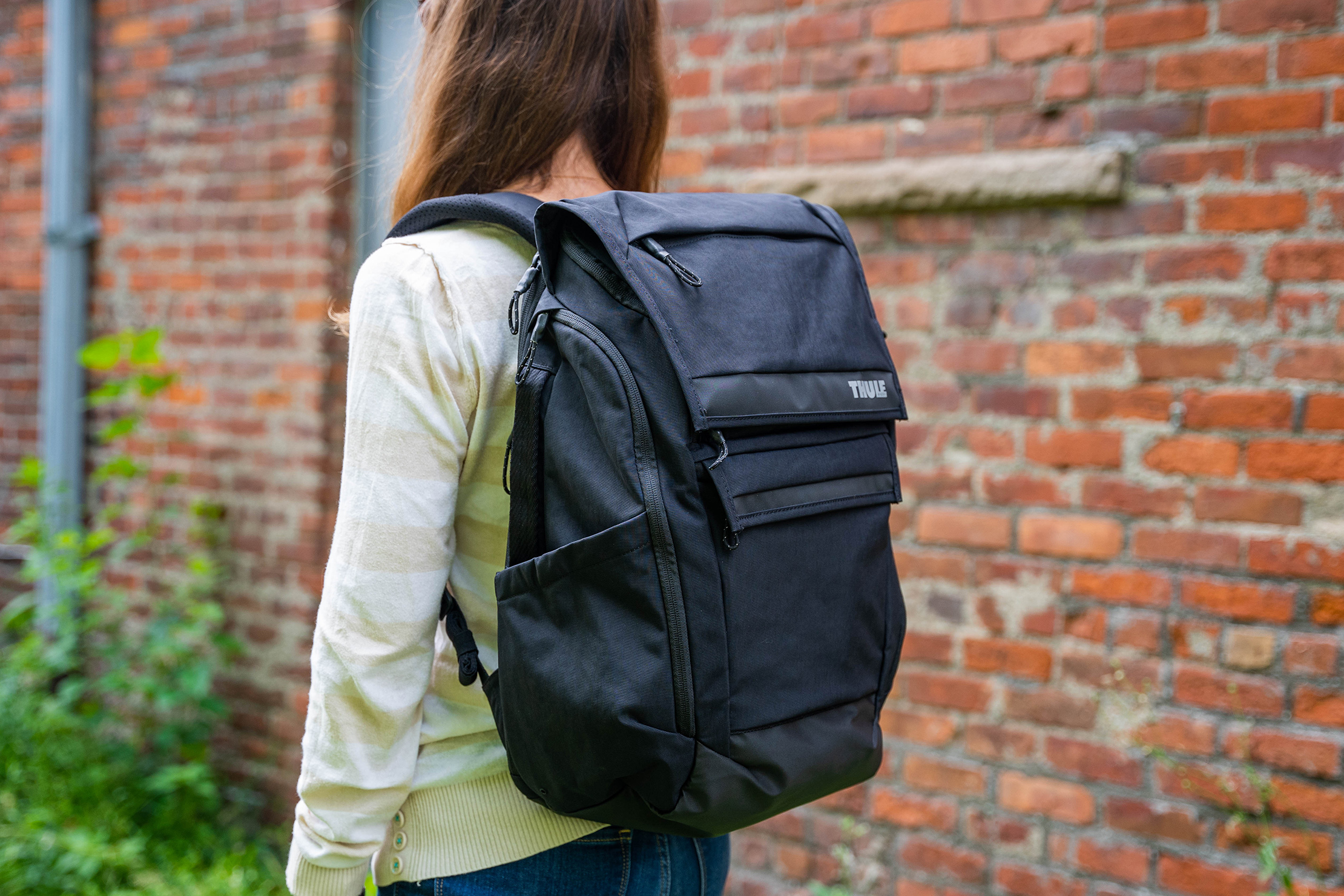
How does it all come together? Let’s find out!
External Components
The Thule Paramount backpack features 420D nylon coated in a water-resistant finish. The 27L version includes other features to protect your gear from the elements, beginning with a fabric welt covering the top quick-access pocket. A large flap containing the quick-access pocket protects the main compartment zipper. It, and a smaller flap over the front pocket, attach via magnets to the bag, which is both satisfying to close and adds protection from the elements. The top flap has two places where the magnets can connect: right above the front pocket flap and a little higher up, depending on how much you pack in the main compartment. We find, however, that the top magnetic attachment doesn’t always connect when we have the main section stuffed to the brim. The flap is still covering the zipper; it just isn’t necessarily clicking into place.

As for hardware, Thule uses YKK zippers and Duraflex brands for shoulder strap slides on the Paramount. Each zipper features a paracord-like loop attached with heat shrink to the zipper pull, so they’re all easy to grab, which is nice since there are so many zippers on this bag! All of the zippers unprotected by fabric welts or flaps tuck into zipper garages to prevent water from getting into the pack via the tiny gap between the end of the zipper and the bag—nice!
Thule stamped its logo in reflective silver on the bottom right corner of the bag’s top flap. There’s also a small label with “Thule” on the left shoulder strap. That’s it, though—there isn’t even any branding or logo inside the bag.

At the top of the bag is a beefy, cushioned carry handle that includes breathable mesh on its underside to keep your hand from sweating when you carry it. We primarily use it for popping it in and out of a vehicle, and if you have to tote the bag for extended periods via the carry handle, it will not be uncomfortable. One side of the bag features another, less cushiony carry handle for pulling it out of a trunk or overhead compartment.

Of course, this is a backpack, so we’re carrying it that way. Luckily, the shoulder straps feature the same cushioning and breathable mesh as the back panel, which is where it counts. Each strap has a loop for connecting small items you like to keep close at hand, and the left strap also includes a slip pocket for a metro card or bus pass. The shoulder straps are it for the harness system; there are no additional sternum or waist straps on this commuter daypack.

The back panel is also nicely padded with two vertical pieces of ridged padding parallel to where the shoulder straps connect, although the padding is wider than the straps. A coarser mesh covers this padding, though it’s not abrasive. It’s a softer, smaller version of mesh you might see in a ball cap, whereas the mesh on the straps is more like basketball shorts. Separating the two panels is a channel where air can get through to help you avoid a sweaty back—as much as is possible while wearing a black backpack.
Fit Notes
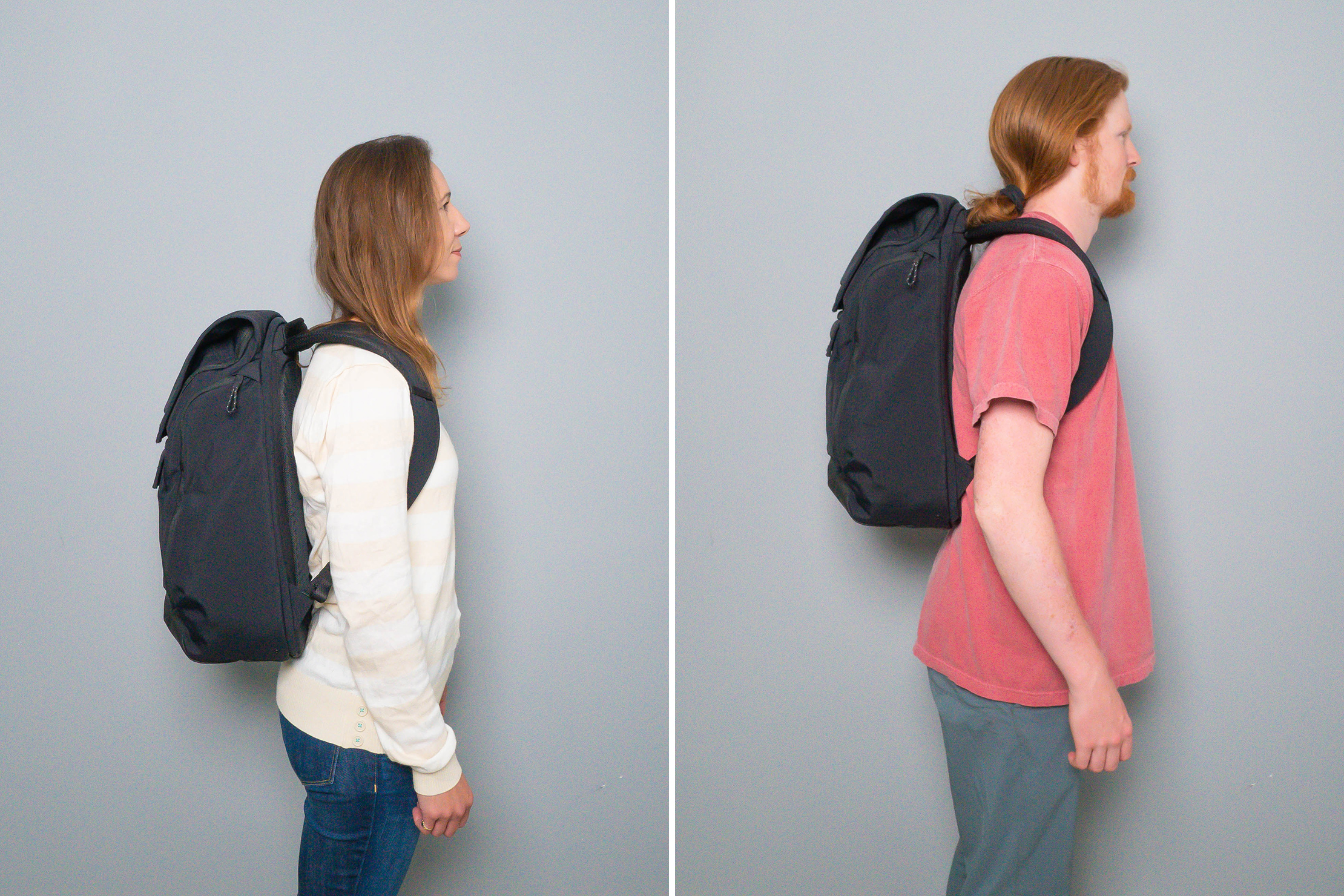
As of this writing, black appears to be the only colorway available, and that’s fine with us. The colorway and style of the bag give the Paramount a ruggedly professional look. Overall, the bag feels very sturdy. It’s not a tactical bag, though we get a vibe that this bag can take whatever life throws at it. It certainly handles torrential downpours with no problem! Yet it’s not out of place in a professional setting once you’ve dashed in from the rain.
The shoulder straps and back panel padding combine for a comfortable carry, for the most part. The straps are flexible enough to accommodate different body types and are adjustable via the Duraflex slides at the bottom. There are elastic strap keepers, so you can lock it in once you find the right fit. Some members of the Pack Hacker team with broader shoulders feel the straps pull at their traps (the trapezius muscles are a pair of large triangular muscles extending over the back of the neck and shoulders). A sternum strap may be a welcome inclusion in future iterations of this backpack; however, there’s no extra support as of now. Those with narrower frames may not miss it.
Inside The Pack
Pockets, pockets, and more pockets! That’s what’s in this bag. While we appreciate the extra organization, we sometimes forget which pocket is holding what. That can be a good problem, though, to have a place for everything and everything in its place—with long-term use, we think it’s a pro, not a con.

Let’s start at the top of the front of the bag, shall we? Here we have an 11-inch wide by 7-inch deep pocket on the outside of that front flap we were discussing earlier. It’s a great spot to toss anything we like quick access to, like a wallet, cash, tissues, and more. Unlike with some bags, where overloading a pocket like this causes the bag to collapse, putting more in this pocket seems to help the flap lock into place with the magnets.
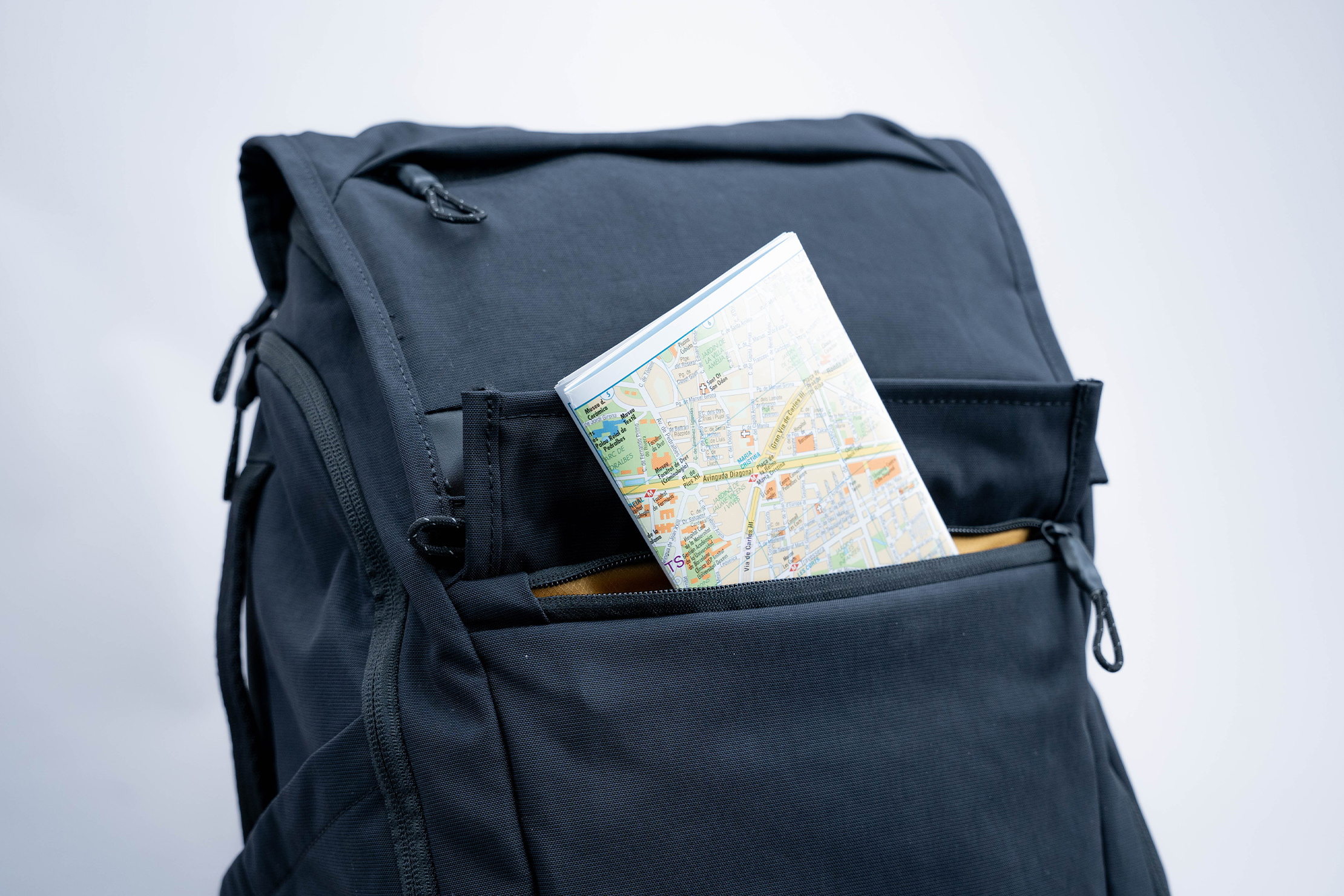
Moving down the front, we have the “main” front compartment. A large magnetic flap covers it, and its zipper still zooms home into its little garage. This section is 7 inches deep and a little over 8 inches wide. We use it for things we like to keep close to hand, like lip balm and other toiletries. The plethora of pockets around the Paramount lets you decide what works best for your situation and go with it. We’ll just continue with suggestions as we go along.

Now, let’s rotate the bag clockwise and look at the right-hand side. Here we have a slender admin panel built into the side of the pack. We open it to find a gold ripstop nylon liner and, on the outer flap, an 8-inch tall zippered mesh pocket containing a key clip on a leash a couple of inches long. Keys are all we end up putting in there, though it’s nice to keep them in a dedicated spot rather than trying to remember which pocket we tossed them in and rummaging at the bottom. Opposite this, adjacent to the bag’s interior, are two top pockets: a 2-inch one that comfortably holds two pens and a 4-inch wide pouch for smaller gear like a battery bank. Below is another mesh pouch about 6 inches wide for more tiny accessories: AirPods, flash drives, and more work well here.

Time to turn the bag clockwise again because on the back panel we have—you guessed it!—another pocket. Next to the shoulder strap on the user’s left side, running vertically along the edge of the back, is a 7.5-inch zippered pocket. It’s hidden for a reason; you can stash your passport and other important yet flat items here to protect them from pickpockets. If you don’t need it, it’s very discreet; we haven’t had it get in our way or come unzipped for any reason.
Ready? Turn! The last side of the bag (the user’s left as you’re wearing it) features the final two zippers we see outside the bag. We like these because there’s one con to the front flap keeping our gear dry in the rain—it gets in our way every time we want to get in the bag. Luckily, these two zippers solve that problem. They provide side access to the different sections of the main compartment.

One zipper runs along the edge of the back panel and the side of the bag. It allows access to the padded laptop sleeve, which fits up to a 15.6-inch computer. Though you may not notice it right off the bat, there is also a side-facing pocket on the back side of the laptop sleeve (not along the back panel) to slide in a 10.5-inch tablet. That’s because you can’t grab a tablet from its other sleeve from this side access. We find ourselves using this side access daily to quickly grab and stow a computer without having to open up the main compartment from the top.
The other zipper mirrors the zipper on the right. This one, however, provides side access to the main compartment. Again, this is great to avoid going through the flap as well as a zipper, and it has an added advantage, as well; it’s easier to slide in bulkier items this way than through the top. There is a fair amount of space at the bottom of the bag. Depending on what you store in interior pockets, pouches, and sleeves, it can be harder to push past them with a larger item, like a small lunch cooler. Going in through the side lets us take advantage of that space much easier.
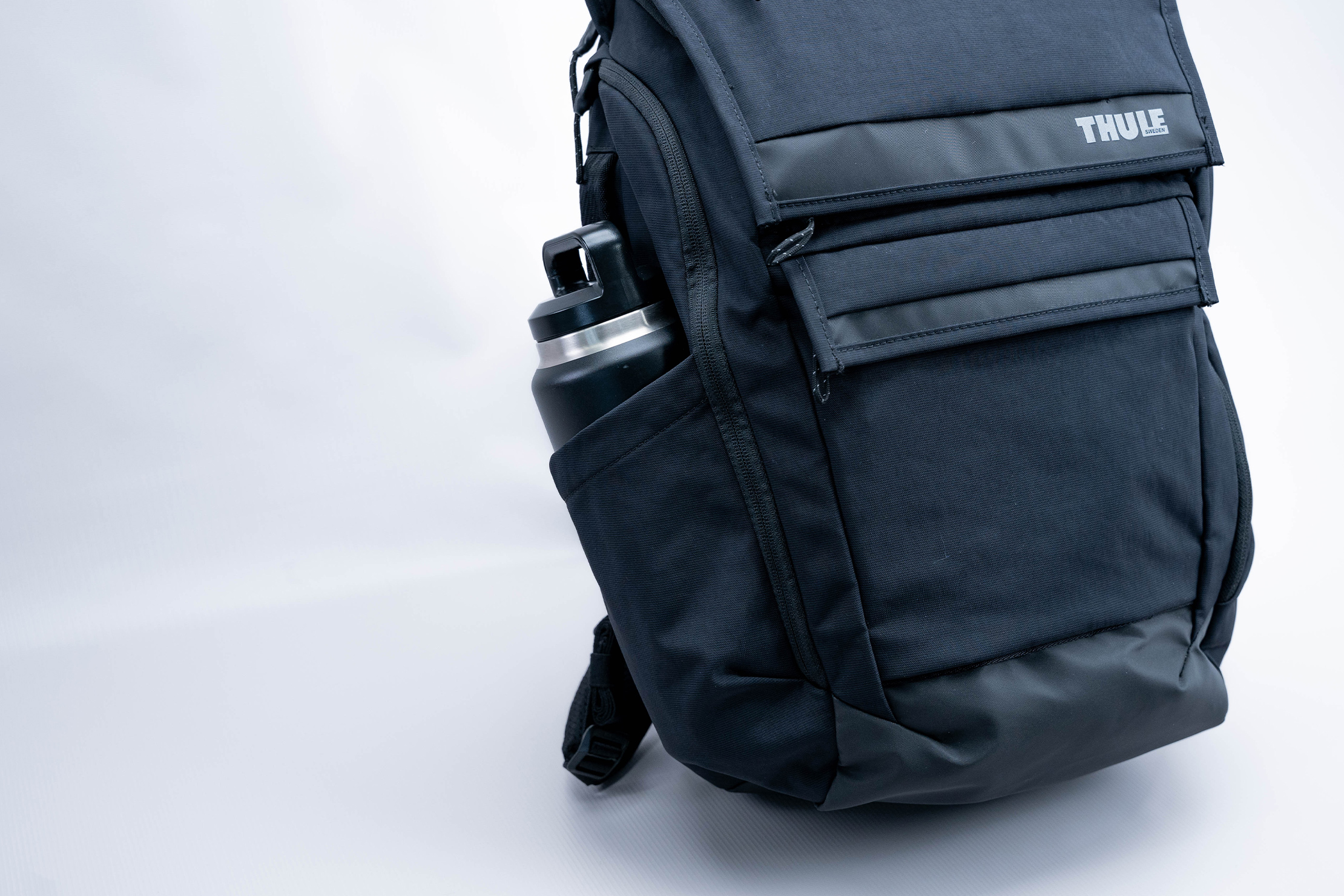
Also on this side is the extra handle and a water bottle pocket. It easily holds even a wide-mouth bottle, thanks to a piece of elastic at the top that expands or contracts a fabric gusset.

Now we’re back to the front. Open the flap to find … one more pocket, the final on the outside. It’s 8.5 inches wide by 5 inches tall, with rounded corners. It unzips to reveal a soft black microfiber-like lining separated into two sections by a mesh pouch with an elastic top. You can store glasses, sunglasses, a phone, or anything small you don’t want to be scratched. It works well for this purpose, although we find ourselves stashing our phone in the side admin panel daily as it is much easier to access. Transporting reading glasses to and from the office without a separate protective case works well; the slight padding of this pocket and the extra protection from the top flap protect them well.
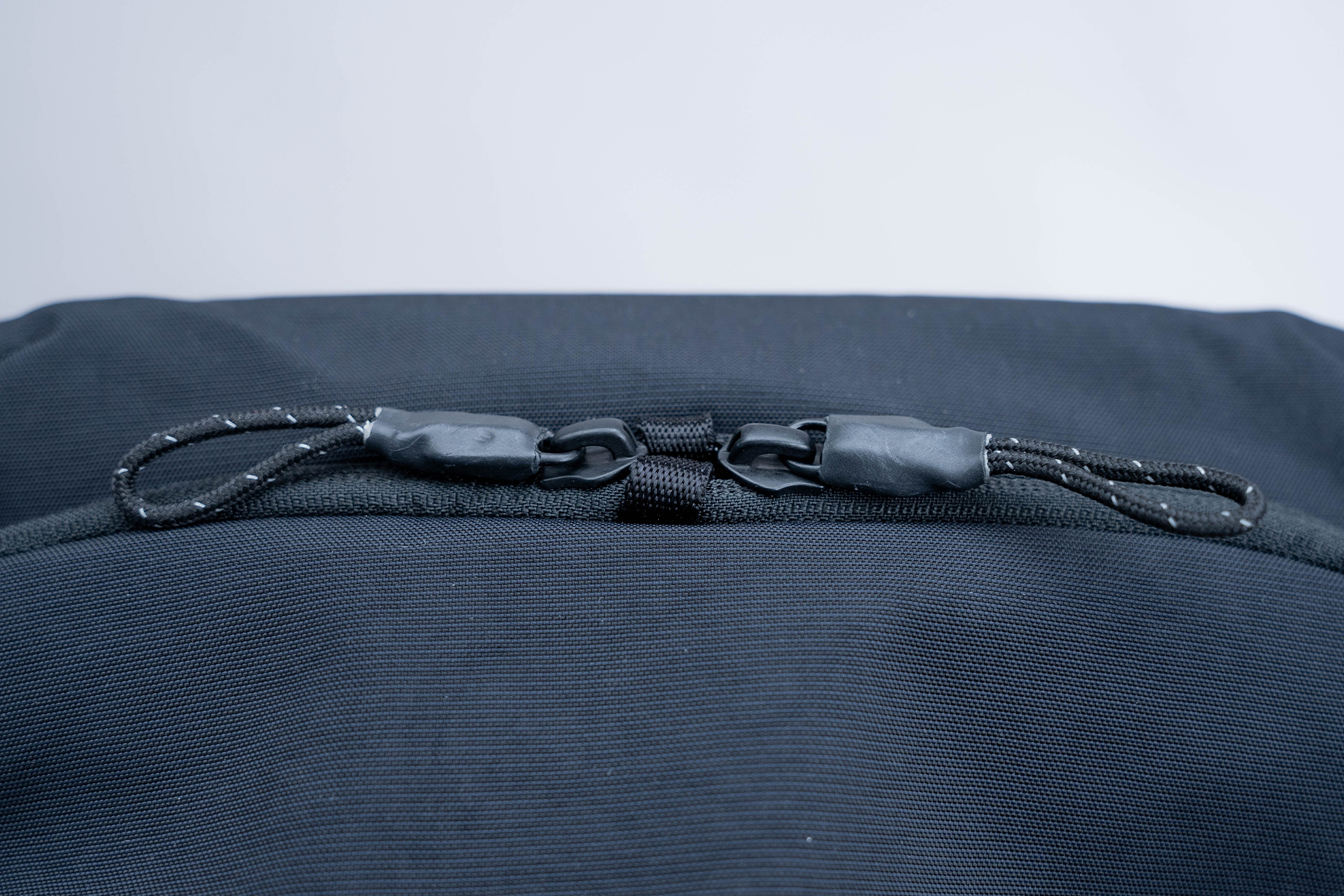
Now to the main compartment! It opens with two zipper pulls joining in the middle, where two small fabric loops stop them. This is part of the water-resistant nature of the bag—if the zippers could move freely between both sides of the opening, there may be a chance of water getting into the main compartment. Having them meet in the middle puts them square in the middle of the front flap, which is added protection from the elements. The zippers open in a U-shape down to the bottom of the soft pocket, which nearly lines up with the top of the water bottle pocket. From the center, that’s about 13 inches down on each side, providing a large amount of access to the main compartment, which we like. It is still a top loader; however, with the wide opening at the top and the side access, we don’t have a problem storing or unpacking items that take up the entire bottom of the bag.
The same gold ripstop nylon lines the main section as we see in the admin panel. Surprisingly (or maybe not), there isn’t a ton of organization inside here. It’s enough, especially when we factor in all the other pockets scattered throughout the backpack.
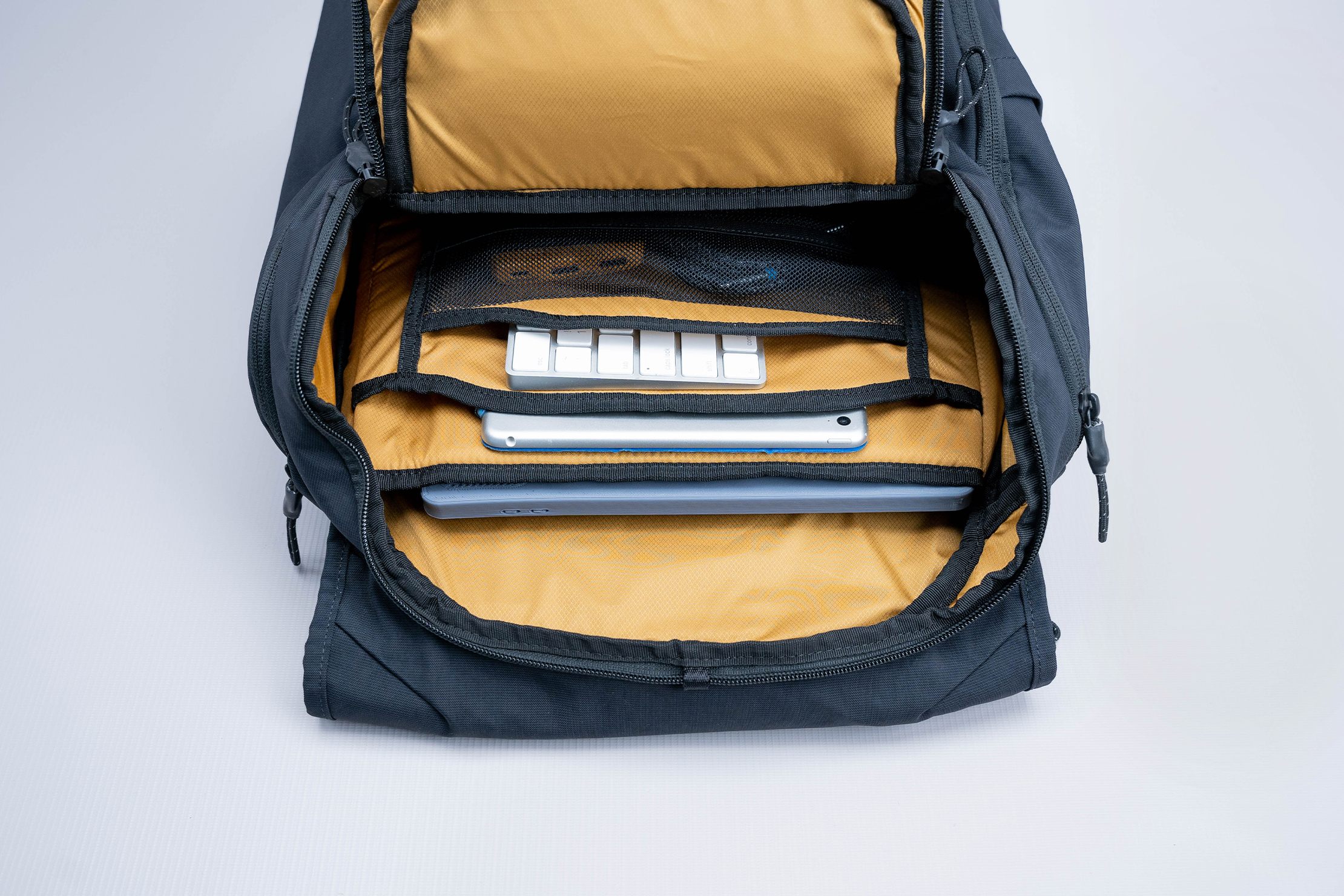
Along the back is top access to the laptop sleeve, which spans the width of the backpack and is well padded all the way around, including a slight false bottom to protect a device from drops. Attached to the front of that is a sleeve that’s 1 inch shorter and about 2 inches narrower than the laptop sleeve. It’s another place to pop an iPad or tablet, or frankly, a second 13-inch laptop fits here with plenty of room to spare. The padding on this sleeve isn’t quite as robust, however.
In front of that is a third sleeve that’s another inch shorter and another 2 inches narrower. It is also lightly padded and a great spot for a wireless keyboard. And on the front of that sleeve is the last piece of internal organization: a 9.5-inch wide mesh pocket. The actual pocket is about 5 inches deep, and a 2-inch piece of the same mesh comes down from the top. Both mesh edges have elastic, creating a slip pocket with a lid perfect for large wall chargers, cords, a mouse, and the other tech we carry daily. Just realize that it’s all together, so some sort of cable management comes in handy. Or bring your tech pouch and use this pocket for a small notebook or novel.
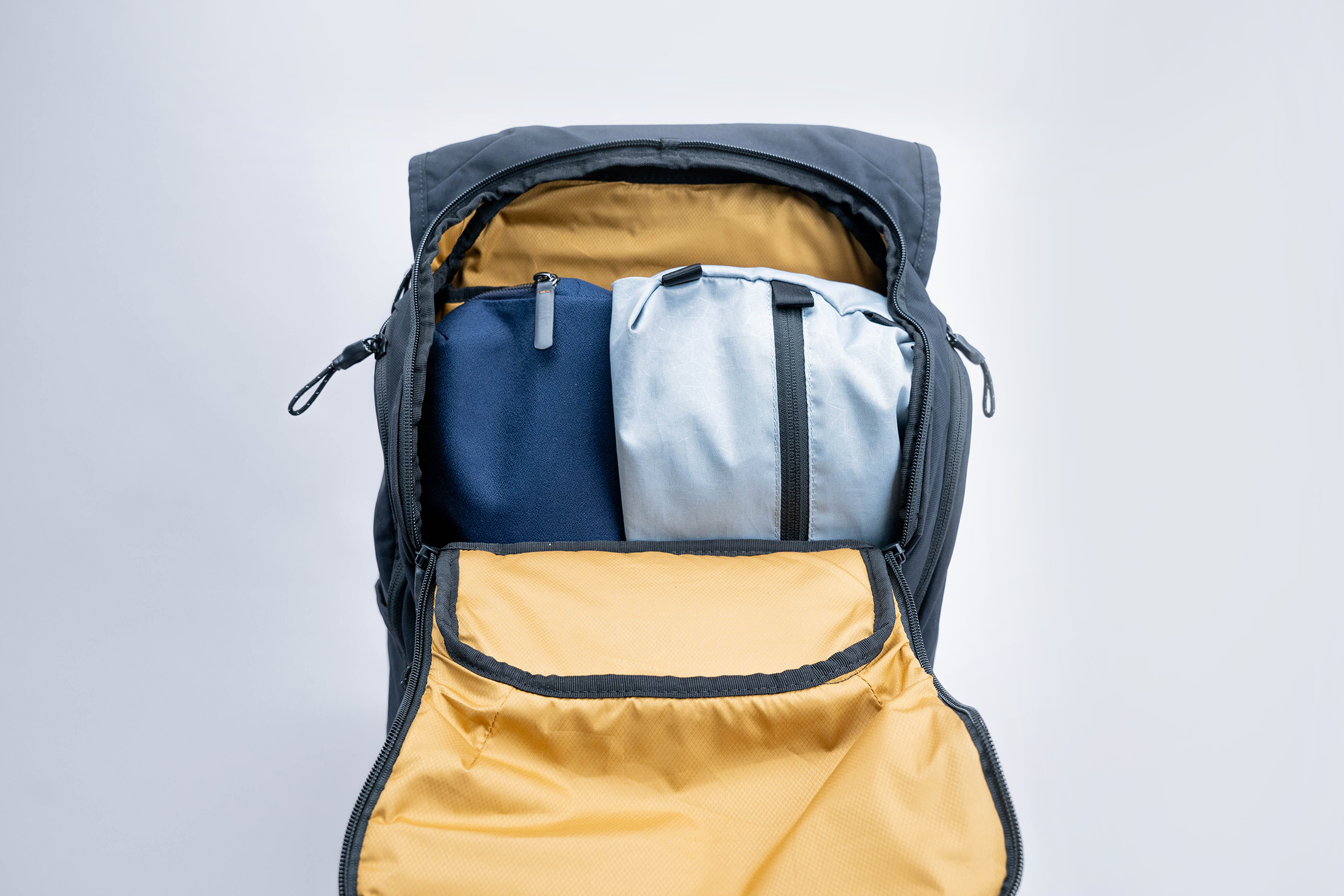
The rest of the space is open for your everyday carry needs or packing cubes for a weekend trip. Or nothing. The nice thing about the combination of the side zippers and the front flap magnets is that the bag has enough structure to look sleek instead of sagging, even when not fully packed. With everything put together, we think this is a nice-looking EDC or travel bag we’re happy to be seen carrying.
Usage Timeline
Condition: Excellent
- Flaps snap shut with adjustable magnetic closures
- Looking forward to testing the quick-access side organization
- Fabric feels very durable, albeit crunchy
Condition: Excellent
- Digging all the organization
- Weather-proofing features work well in downpours
- Comfortable to carry, depending on the user


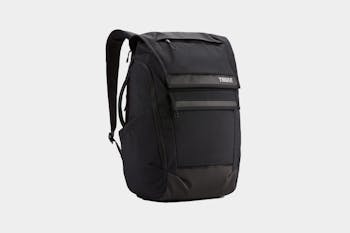






Get your questions about the Thule Paramount (27L) answered from our team and the Pro Community right here on the page. Plus, join discussions with other members about gear, guides, and more.
Join Pack Hacker Pro or, Sign In